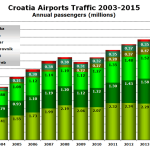Croatian airports have never seen such huge number of passengers, but they do not have capacity to keep breaking records.
In the first seven months of this year, Croatian airports have seen record numbers of passengers. Just in July, nine Croatian international airports have seen nearly a million and a half passengers, and in the first seven months of the year, there were about 4.4 million passengers, announced the Croatian Chamber of Economy, reports Jutarnji List on September 14, 2016.
Among the largest Croatian airports, the highest growth in the first half of the year was recorded in Split, which had an increase of 25.4 percent compared to the first six months of last year, in Dubrovnik with 16.4 percent more passengers, and in Zadar with 15.3 percent more passengers. The Zagreb Airport recorded an increase in passenger numbers of 10.4 percent. Excellent results continued in August as well, with Zadar airport recording 101,919 passengers, which is the highest number of passengers in one month in the history of the airport.
“The major factor in the increase in demand for air transport services is GDP growth. Apart from the fact that in most EU countries, from where our passengers mostly come, GDP and thus the purchasing power have increased, there are also many other factors which have affected the increase in traffic in the Croatian skies. One of them is the increased tourist demand for Croatian resorts, as a result of reduced visits to some traditional European and North African destinations such as Turkey, Tunisia and Greece”, explains Tonči Peović, the president of the Air Transport Association at the Croatian Chamber of Economy.
He believes that airlines have somewhat lowered average ticket prices, which is a consequence of the reduction in oil prices on the world markets. Another factor which has also influenced the increase in air traffic in Croatia is shortened stay of tourists in some destinations, approximately two to three days. “These factors, in addition to low-cost carriers which are present at Croatian international airports in Zagreb, Split, Dubrovnik, Zadar, Pula, Rijeka and Osijek, have enabled more frequent arrival of tourists, which led to an increase in the number of passengers”, says Peović.
However, airports do not have enough capacities for such huge increase in traffic, and the question is whether they can accommodate more passengers. “In the following years, the main challenge for airports will be how to respond to additional demand in the peak season. However, construction projects at airports in Zagreb and Dubrovnik will soon be finished, and it is expected that construction works in Split will begin soon”, says Ljubica Herceg, director of the Transportation Department at Croatian Chamber of Economy.








